Is it possible or not to eat eggplants for type 2 diabetes: benefits and harms, recipes
Chinese wisdom says: “To heal your body, you need to change your lifestyle.” For patients with type 2 diabetes, it can be a clue on the path to healing. Changing the diet for diabetics is one of the conditions for antidiabetic therapy.
The general recommendation of endocrinologists for diabetics is to introduce more vegetables and fruits into the diet. Eggplants are often a substitute for potatoes, which are prohibited for diabetes. But their thoughtless use can cause the disease to worsen. From the article you will learn about the composition of the product, whether or not you can eat eggplants for type 2 diabetes, indications and restrictions for its use.
The benefits and harms of eggplants for type II diabetes mellitus
The beneficial and harmful properties of these vegetables are determined their composition.
Chemical composition of eggplants
Purple vegetables contain a number of beneficial vitamins and minerals:
- ascorbic acid – participates in collagen synthesis;
- B vitamins – necessary for normalizing metabolism;
- vitamin PP – strengthens the walls of blood vessels;
- carotenes – improve twilight vision;
- tocopherols – vitamins of youth, neutralize free radicals;
- vitamin K is a component of the blood coagulation system;
- potassium and magnesium – reduce the excitation of smooth and cardiac muscles;
- manganese, copper, iron and zinc - are part of enzymes;
- calcium – tones skeletal muscles.
The pulp contains a large amount of fiber, preventing the rapid absorption of carbohydrates.The peel is rich in enzymes that improve blood circulation. Another useful component is anthocyanins, they have antioxidant properties and give eggplants their purple color.

Nutrient content
Per 100 g there are:
- proteins – 1.2 g;
- fat – 0.1 g;
- carbohydrates – 4.5 g;
- calorie content – 24 kcal.
These figures apply to raw vegetables. Depending on the cooking methods (frying in oil, boiling, stewing, etc.), the values of KBJU may vary.
Indicators baked and boiled eggplants:
- calorie content – 42.8 kcal;
- proteins – 1.4 g;
- fats – 2.3 g;
- carbohydrates – 4.2 g.
 Indicators fried eggplant:
Indicators fried eggplant:
- calorie content – 132 kcal;
- proteins – 0.8 g;
- fats – 8.1 g;
- carbohydrates – 10.2 g.
Stewed eggplant:
- calorie content – 38 kcal;
- proteins – 1.2 g;
- fats – 1.9 g;
- carbohydrates – 5.2 g.
Canned eggplant:
- calorie content – 50 kcal;
- proteins – 0.9 g;
- fats – 0.7 g;
- carbohydrates – 7.27 g.
Glycemic index of eggplant
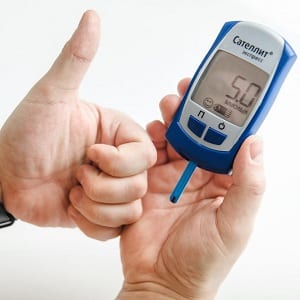 For patients with type 2 diabetes when choosing food It is not so much the carbohydrate content that is important, but the glycemic index of the product.
For patients with type 2 diabetes when choosing food It is not so much the carbohydrate content that is important, but the glycemic index of the product.
The value of this indicator indicates the rate of change in blood sugar levels after eating. The higher the glycemic index, the greater the sugar load the body experiences when consuming a product.
The glycemic index of eggplant is 15. This means that two hours after eating 100 g of eggplant, 100 x 0.15 = 15 g of glucose will be found in the blood. This glycemic index value is low, so diabetics can consume eggplant in significant quantities.
This is interesting:
Possibility of eating eggplants for type II diabetes
Let's figure out what they are Pros and Cons of Including Purple Vegetables in Your Diet for Diabetics.
Arguments for":
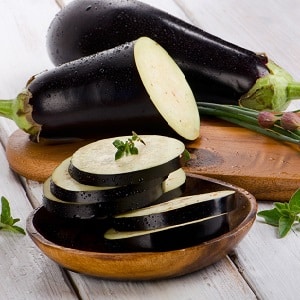 In diabetes mellitus, the blood vessels are primarily affected. Vitamins C, PP, and B contained in eggplants strengthen the vascular wall and promote its regeneration. This helps reduce the risk of vascular pathologies and alleviate the condition of patients.
In diabetes mellitus, the blood vessels are primarily affected. Vitamins C, PP, and B contained in eggplants strengthen the vascular wall and promote its regeneration. This helps reduce the risk of vascular pathologies and alleviate the condition of patients.- A common disease associated with diabetes is obesity. The low calorie content and glycemic index of the purple vegetable indicate its possible use for weight loss.
- Patients with diabetes constantly take medications that can negatively affect the liver. The iron, manganese and copper content in eggplant helps restore the amount of anti-toxic liver enzymes.
- With atherosclerosis accompanying diabetes, eggplants will help reduce the amount of cholesterol in the blood.
- Zinc, which is part of the fruit pulp, stimulates the synthesis of insulin in the pancreas and increases the sensitivity of tissues to this hormone.
Arguments against":
- Housewives prefer to use eggplants for frying. Fried and fatty foods only aggravate the condition of patients with type 2 diabetes.
- Overripe purple vegetables contain excess amounts of solanine, a toxin that damages liver cells. White varieties of eggplant contain a minimal amount of it, and therefore are considered harmless in this regard.
- Risk of food allergies. Allergy sufferers and patients with immune disorders should be careful when introducing large amounts of eggplant into their diet.
Correct usage
Taking into account the quantitative carbohydrate indicators of these vegetables you can introduce them into the diet for diabetes with almost no restrictions.
Reference. The average annual consumption per person is 2-5 kg of raw eggplants.
 Introduction to the diet of vegetables Helps reduce calorie intake, but do not forget about moderation.
Introduction to the diet of vegetables Helps reduce calorie intake, but do not forget about moderation.
Should limit or stop consuming purple vegetables if you notice manifestation of such undesirable reactions of the body:
- sharp or aching pain in the stomach or intestines - evidence of exacerbation of inflammatory processes - for example, gastritis, enterocolitis or duodenitis;
- pain in the right or left hypochondrium is a sign of inflammation of the liver or pancreas;
- Irregular bowel movements - possible due to excess fiber consumption;
- pain in the kidneys is a sign of inflammation or exacerbation of urolithiasis;
- redness, peeling, itching of the skin are signs of allergic reactions.
Recipes for eggplant dishes for type II diabetes
For patients with diabetes, it is recommended to exclude fatty, fried and sweet foods from the diet.. The amount of starchy foods is also reduced.
To make your updated diet not only healthy, but also tasty, take note of the recipes.
Sauteed eggplant
Ingredients:
- eggplants – 4 pcs.;
- onion - one head;
- carrots – 2 pcs.;
- sweet pepper – 2 pcs.;
- tomatoes – 4 pcs.;
- garlic – 4 cloves;
- greens - to taste.
Eggplants are cut into cubes and soaked in salted water for 30 minutes - this removes the bitterness. Cut the onion into half rings, carrots and peppers into cubes, tomatoes into slices. Garlic and herbs are crushed in a blender or using fine chopping.
Place vegetables without oil in a cauldron or deep frying pan, add a little salt to release the juices and simmer with the lid closed over low heat for half an hour.If necessary, add half a glass of water to prevent the vegetables from burning. Then add herbs and garlic and simmer for another 5-10 minutes.
Eggplant stew
Ingredients:
- zucchini – 2-3 pcs.;
- eggplants – 3 pcs.;
- sweet pepper – 2 pcs.;
- tomatoes – 2-3 pcs.;
- onion – 1 pc.;
- carrots – 1 pc.;
- salt - to taste;
- pepper - to taste.
Peel the eggplants, cut into cubes and soak in salted water for 15 minutes. Zucchini and carrots are peeled and cut into cubes. The onion is cut into half rings or chopped in a blender. Tomatoes and peppers can be cut into cubes or slices, if desired, peeled (in boiling water for a minute, then in cold water).
In a cauldron or deep frying pan, simmer salted vegetables over low heat with a small amount of water and stirring occasionally so that the mixture does not burn. When the vegetables are soft, add seasonings and let sit for 5 minutes with the lid closed.

Steamed eggplant salad
Ingredients:
- eggplants – 3 pcs.;
- tomatoes – 3 pcs.;
- cucumbers – 3-4 pcs.;
- sweet pepper – 2-3 pcs.;
- red cabbage - half a head;
- greens, salt, pepper - to taste.
The eggplants are peeled, cut in half, and soaked in salted water for half an hour. Next, boil water in a slow cooker or double boiler, place the eggplants on a sieve over steam, close the lid, and cook for 15-20 minutes.
Then cut the tomatoes into slices, cucumbers into half rings, peppers into cubes, cabbage into small strips. The finished eggplants are cut into cubes. All ingredients are mixed, herbs, salt and seasonings are added.
Baked eggplant caviar
Ingredients:
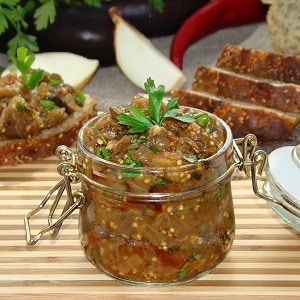 eggplants – 5 pcs.;
eggplants – 5 pcs.;- sweet pepper – 3-4 pcs.;
- onion – 1 pc.;
- garlic – 3-5 cloves;
- salt, pepper - to taste.
Eggplants and peppers should be washed and placed with their stems on a baking sheet covered with parchment paper. Then preheat the oven to +200 °C, place a baking sheet with vegetables in it, and bake for 30-40 minutes. To prevent vegetables from burning, turn them over periodically.
When the eggplants become soft and the peppers wrinkle, remove the vegetables and cool in air to a comfortable temperature. Prepared vegetables are peeled and stalked, and seeds are removed from peppers.
Grind onions, garlic, peppers and eggplants in a blender until smooth. If there is no blender, grate the onion and garlic, and grate the vegetables with a fork. Then add salt and seasonings to taste and mix.
Boiled eggplants with cheese and garlic
Ingredients:
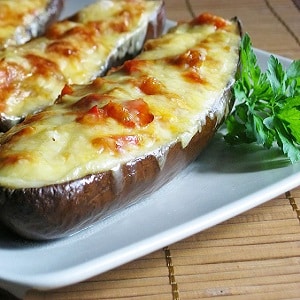 eggplants – 1 pc.;
eggplants – 1 pc.;- hard cheese – 30 g;
- garlic – 2-3 cloves;
- parsley – 2-3 sprigs;
- olive oil – 1 tbsp. l.;
- salt - to taste.
Eggplants are cut lengthwise and the stems are cut off. The cheese and garlic are grated, the greens are chopped. Cook the eggplant halves in boiling salted water for 10-15 minutes. Place the finished eggplants on a paper towel and dry.
While the vegetables are hot, sprinkle them with cheese on the cut side. Mix olive oil, garlic and herbs in a bowl. The resulting mixture is placed on top of the melted cheese. The dish is served cold as a snack.
Bon appetit!
Read also:
Traditional medicine recipes
The peel of purple fruits is used for medicinal purposes in diabetes mellitus., containing anthocyanins, so only it is harvested. Use the skins of young eggplants, as overripe fruits contain excess amounts of solanine.
It is better to prepare the peel during harvesting.. The vegetables that you find on store shelves in winter have been stored in warehouses and storage facilities for a long time. Even if the fruits were picked young, solanine accumulates in them during storage.
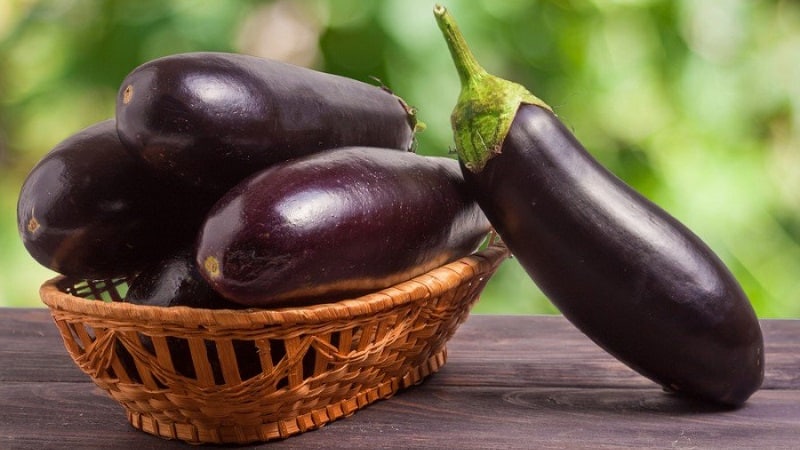
Pay attention to the quality of the fruit. Fruits that are rotten or infected with plant parasites are not suitable for use.
Attention! Before taking traditional medicine, consult an endocrinologist!
Infusion of eggplant peel
50 g of fresh washed peel is poured into a thermos with 0.5 liters of boiling water and left for 8-10 hours.. Afterwards, the infusion is filtered and the peel is squeezed out. Take half a glass before meals.
It has antioxidant, choleretic, hypoglycemic properties. Used for anemia, liver and biliary tract diseases, diabetes, pancreatitis, obesity.
Peel powder
To continue the course of treatment with eggplant peel all year round, it can be dried in air or in an electric dryer and ground into powder using a mortar or coffee grinder. Dry powder is stored in airtight containers for a year.

5 g of powder is brewed with 500 ml of boiling water, left for 2-3 hours, then filtered. Take half a glass before meals.
Antidiabetic mixture with eggplant peel
Mix in equal parts by weight:
- dry blueberry shoots;
- nettle leaves;
- flax seeds;
- rhizomes and roots of elecampane;
- dry eggplant peel;
- chicory root;
- milk thistle fruits;
- corn silk.
3 tbsp. l. the collection is brewed in a thermos with 500 ml of boiling water, left for 10-12 hours. Drink half a glass hot half an hour before meals.
Attention! Traditional medicine does not replace standard antidiabetic drug therapy. Do not stop taking medications without instructions from your doctor!
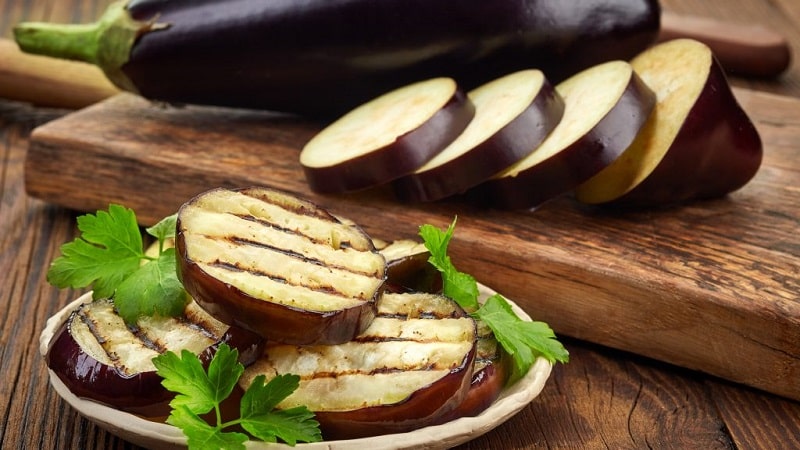
Precautionary measures
Carefully introduce eggplant dishes into your diet if you have diabetes you have the following diseases:
- Gastritis, enterocolitis or duodenitis. Organic acids contained in vegetables can irritate the walls of the gastrointestinal tract.
- Pancreatitis. Eggplant dishes containing oil increase the load on the pancreas.
- Urolithiasis disease. Purple fruits contain a lot of oxalates, which contribute to the formation of kidney stones.
- Immune disorders. The diet of allergy sufferers excludes the constant consumption of the same type of foods; eggplant in this case is no exception. Diversify your diet with other types of foods.
- Erythrocytosis. Purple vegetables stimulate hematopoiesis; people with high levels of hemoglobin and red blood cells should limit their consumption of this vegetable.
- Vein thrombosis. Vitamin K and calcium contained in the fruit pulp stimulate blood clotting, which increases the formation of blood clots.
Conclusion
Eggplants may be good for diabetics. But in order for the consumption of this vegetable to be rational and not cause harm, it is important to follow the rules: include only young fruits in the diet, use cooking, stewing or baking, and observe moderation. And, most importantly, if unpleasant consequences occur, abandon them and seek advice from a doctor.